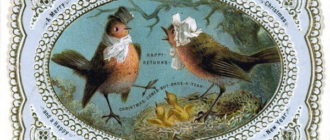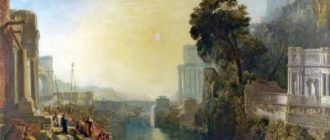
“Vladimirka” is a painting by Isaac Ilyich Levitan based on a sketch made during his stay in the village of Gorodok near the Peksha River, in the Vladimir region. The canvas depicts an endless space under a low, cloudy sky, a tiny white church on the horizon and a figurine of a praying mantis by a cabbage roll – a milestone with an icon.
On the sides of the unpaved, partly overgrown tract, there are trampled yellow paths. Ahead, the artist marked a descent into a shallow ravine and a new ascent, behind which is the same path amid emptiness and loneliness. The feeling of windy weather was created by Levitan with the help of lilac-gray stalks of grass. They disperse in waves in different directions. Green trees dark to black, gray dust on the ground, muted colors of the surrounding nature speak of the approach of autumn. Gloomy terrain gives rise to a feeling of depression, hopelessness before the inevitable arrival of cold weather.
Painting “Vladimirka” by Isaac Ilyich Levitan – landscape as an artistic interpretation of the tragic page of Russian history

Author: Isaac Ilyich Levitan (1860-1900).
Year of writing: 1892
Size: 79 x 123 cm.
Style: Realism.
Genre: Landscape.
Technique: Oil painting.
Material: Canvas.
Location: State Tretyakov Gallery, Moscow.
Isaac Levitan is an outstanding artist of the 19th century, a master of landscape painting, who devoted his work to the expanses of his native land.
As a keen observer and connoisseur of Russian history, in any locality he found something especially characteristic, inspiring to create a new picture.
The testimony of Sophia Kuvshinnikova, who accompanied the master during his stay in the Vladimir region, has been preserved. They walked around the outskirts of Gorodok, a cozy, pastoral view spread around. But suddenly the artist remembered that until recently, it was along this path that criminals sentenced to hard labor were convoyed to Siberia.
The trampled stripes on both sides of the main road are the traces of a horse convoy, which always moved at a distance from the main column. Isaac Ilyich, captivated by the idea of a new work, returned to the place many times, made several sketches. Only one sketch, painted in oil on cardboard, has survived to our time. On his return to Moscow, the author created the final version of the painting “Vladimirka”.
In 1893, the work was presented at the 21st exhibition of the Itinerants and received critical acclaim. But no one was in a hurry to acquire it. A year later, the author presented his brainchild to the Tretyakov Gallery, admitting that he wants to calm down at last and not cherish the hope of bailing out money for it.
The painting “Vladimirka” by Isaac Ilyich Levitan, in the opinion of his contemporaries, has earned the title of historical landscape. It shows the author’s mature skill, his ability to convey an emotional mood. Having depicted the typical terrain of the Central Russian strip, he reminded the descendants of whose feet this road was trampled.






